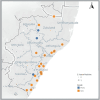A comparative analysis of the prevalence and intensity of schistosomiasis and soil-transmitted helminth infections between preschool-aged children and school-going children in KwaZulu-Natal Province
- PMID: 40455295
- PMCID: PMC12130080
- DOI: 10.1007/s00436-025-08504-1
A comparative analysis of the prevalence and intensity of schistosomiasis and soil-transmitted helminth infections between preschool-aged children and school-going children in KwaZulu-Natal Province
Abstract
The World Health Organization (WHO) recommends conducting a baseline survey to quantify the infection burden of schistosomiasis and soil transmitted helminths (STH) in pre-school aged children (PSAC) and school-aged children (SAC) before implementing a schistosomiasis mass drug administration intervention. The objective of the study was to compare the prevalence and intensity of schistosomiasis and soil-transmitted helminth (STH) infections between preschool-aged children (PSAC) and school-age children (SAC) in the province of KwaZulu-Natal, South Africa. The study was conducted in the province of KZN. The target population was PSAC and SAC, with a sample size of 2000 children (1176 primary school-aged children and 824 pre-school-aged children). Ethical clearance was obtained from the Biomedical Research Ethics Committee of the University of KwaZulu-Natal; informed consent from parents/legal guardians and verbal assent from SAC were solicited. Data collection involved collecting stool and urine samples from children. The prevalence and intensity of infections were compared between PSAC and SAC, using statistical methods to assess differences. The results showed that 49 (4.2%) SAC were positive for Schistosoma haematobium, while only 3 (0.41%) PSAC were infected. The total number of STH infections among participants was 281 (22%), with 91 in PSAC and 190 in SAC. The chi-square test showed that SAC were infected with schistosomiasis more than PSAC counterparts in the same location. However, the difference in STH prevalence between PSAC and SAC was not statistically significant, suggesting that there was not much of a difference in the prevalence of STH among SAC and PSAC. Among the STH infections, Taenia was the most prevalent, affecting approximately 20.5% of SAC and 23.4% of PSAC. This species accounted for a substantial proportion of the overall STH burden in both age groups. The study concluded that while SAC has a higher overall prevalence, a real burden exists among PSAC indicating the need to include them in MDA programs targeting S. haematobium in the province.
Keywords: Preschool-aged children; Public health policy; Schistosomiasis; School-going children; Soil-transmitted helminths.
© 2025. The Author(s).
Conflict of interest statement
Declarations. Institutional Review Board statement: The University of KwaZulu Natal biomedical research ethics committee (BREC) issued the ethical approval for the protocol: Comparative analysis of the burden of schistosomiasis and soil transmitted helminth infection between pre-school age children in the province of KwaZulu-Natal. Degree: MMedSc. BREC Ref No: BE429/19. Informed consent statement: Informed consent was obtained from all subjects involved in the study. Conflicts of interest: The authors declare no conflicts of interest. The funders had no role in the design of the study; in the collection, analyses, or interpretation of data; in the writing of the manuscript; or in the decision to publish the results.
Figures

Similar articles
-
Village and age based precision mapping of schistosomiasis and soil-transmitted helminths in Chevakadzi ward of Shamva district in Zimbabwe.Sci Rep. 2025 Aug 1;15(1):28136. doi: 10.1038/s41598-025-13202-0. Sci Rep. 2025. PMID: 40750808 Free PMC article.
-
Prevalence and risk factors of schistosomiasis and soil-transmitted helminthiases among preschool aged children (1-5 years) in rural KwaZulu-Natal, South Africa: a cross-sectional study.Infect Dis Poverty. 2019 Jun 16;8(1):47. doi: 10.1186/s40249-019-0561-5. Infect Dis Poverty. 2019. PMID: 31202273 Free PMC article.
-
Prevalence, intensity, and associated factors of soil-transmitted helminth and schistosome infections after multiple rounds of preventive chemotherapy among schoolchildren in five selected district councils in Tanzania.PLoS Negl Trop Dis. 2025 Jul 23;19(7):e0013310. doi: 10.1371/journal.pntd.0013310. eCollection 2025 Jul. PLoS Negl Trop Dis. 2025. PMID: 40700451 Free PMC article.
-
Soil-transmitted helminth infection, loss of education and cognitive impairment in school-aged children: A systematic review and meta-analysis.PLoS Negl Trop Dis. 2018 Jan 12;12(1):e0005523. doi: 10.1371/journal.pntd.0005523. eCollection 2018 Jan. PLoS Negl Trop Dis. 2018. PMID: 29329288 Free PMC article.
-
Prevalence and distribution of soil-transmitted helminth infections in Nigerian children: a systematic review and meta-analysis.Infect Dis Poverty. 2018 Jul 9;7(1):69. doi: 10.1186/s40249-018-0451-2. Infect Dis Poverty. 2018. PMID: 29983115 Free PMC article.
References
-
- Hong S-T, Choi M-H, Kim C-H, Chung B-S, Ji Z (2003) The Kato-Katz method is reliable for diagnosis of Clonorchis sinensis infection. Diagn Microbiol Infect Dis 47(1):345–347. 10.1016/s0732-8893(03)00113-5 - PubMed
Publication types
MeSH terms
Substances
LinkOut - more resources
Full Text Sources

